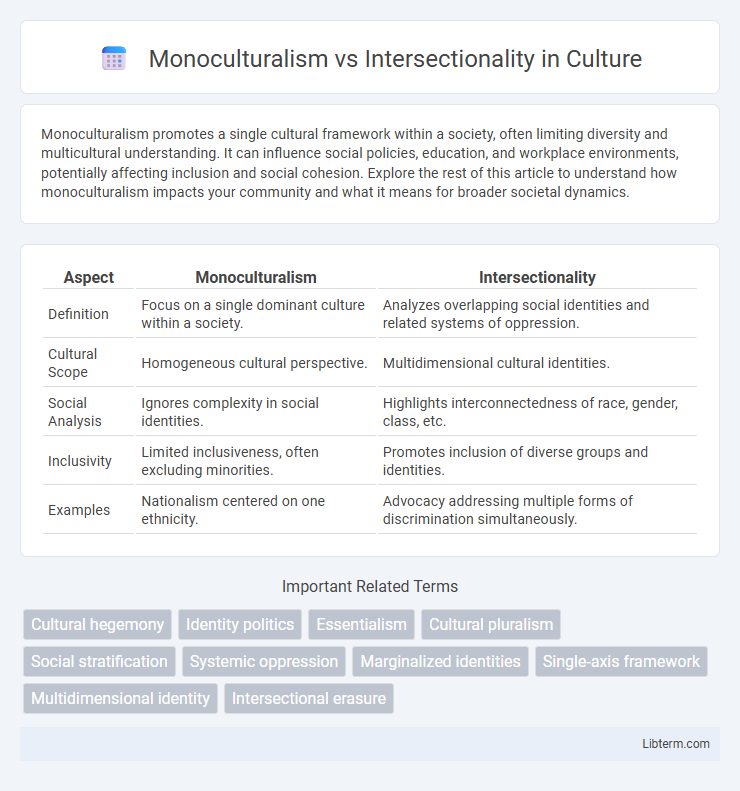Monoculturalism promotes a single cultural framework within a society, often limiting diversity and multicultural understanding. It can influence social policies, education, and workplace environments, potentially affecting inclusion and social cohesion. Explore the rest of this article to understand how monoculturalism impacts your community and what it means for broader societal dynamics.
Table of Comparison
| Aspect | Monoculturalism | Intersectionality |
|---|---|---|
| Definition | Focus on a single dominant culture within a society. | Analyzes overlapping social identities and related systems of oppression. |
| Cultural Scope | Homogeneous cultural perspective. | Multidimensional cultural identities. |
| Social Analysis | Ignores complexity in social identities. | Highlights interconnectedness of race, gender, class, etc. |
| Inclusivity | Limited inclusiveness, often excluding minorities. | Promotes inclusion of diverse groups and identities. |
| Examples | Nationalism centered on one ethnicity. | Advocacy addressing multiple forms of discrimination simultaneously. |
Defining Monoculturalism: Core Principles
Monoculturalism centers on the dominance of a single cultural perspective, often marginalizing minority groups by promoting uniform values, beliefs, and practices. Core principles include cultural homogeneity, assimilation pressures, and resistance to cultural diversity, which can limit social inclusion and equity. This framework contrasts with intersectionality by overlooking the multifaceted identities and overlapping social categorizations influencing individual experiences.
Understanding Intersectionality: A Multilayered Approach
Understanding intersectionality involves analyzing how overlapping social identities--such as race, gender, class, and sexuality--create unique experiences of privilege and oppression. This multilayered approach contrasts with monoculturalism, which tends to view identity through a single cultural lens, often ignoring the complexities of intersecting factors. Intersectionality provides a comprehensive framework for addressing social inequalities by recognizing the interconnected nature of diverse identity markers.
Historical Contexts: Roots of Monoculturalism and Intersectionality
Monoculturalism has roots in colonial and nationalist ideologies that prioritized a single dominant culture while marginalizing others, often reinforcing systemic inequalities. Intersectionality emerged from Black feminist thought in the late 20th century, particularly through the work of Kimberle Crenshaw, to address overlapping social identities and related systems of oppression. These historical contexts highlight how monoculturalism enforces uniformity, whereas intersectionality reveals the complexity of diverse experiences within social structures.
Representation and Identity: Singular vs. Multiple Narratives
Monoculturalism emphasizes a singular narrative that often centers on a dominant cultural identity, limiting representation and disregarding the diversity of individual experiences. Intersectionality explores multiple, overlapping social identities such as race, gender, class, and sexuality, providing a richer, more inclusive representation. This approach acknowledges the complexity of identity, challenging homogeneous portrayals and promoting a nuanced understanding of marginalized communities.
Social Cohesion vs. Diversity: Competing Ideals
Monoculturalism promotes social cohesion by emphasizing a unified cultural identity, often minimizing diversity to maintain societal stability. In contrast, intersectionality celebrates diverse identities and experiences, advocating for inclusivity and equity within social structures. Balancing monoculturalism's cohesion with intersectionality's diversity presents a complex challenge for creating harmonious yet pluralistic societies.
Policy Implications: Education, Law, and Governance
Monoculturalism in education often leads to standardized curricula that marginalize diverse identities, whereas intersectionality promotes inclusive policies recognizing multiple, overlapping social categories, enhancing equity in learning environments. In law, monocultural frameworks may enforce one-dimensional justice approaches, while intersectional policies enable nuanced legal interpretations addressing compounded discrimination and social inequalities. Governance under monoculturalism risks homogenized decision-making, limiting representation; intersectionality fosters participatory models that integrate diverse perspectives for more equitable policy outcomes.
The Impact on Marginalized Communities
Monoculturalism often perpetuates a singular cultural narrative that marginalizes diverse identities, limiting access to resources and social recognition for minority groups. Intersectionality exposes how overlapping social identities--such as race, gender, class, and sexuality--compound experiences of oppression, creating complex layers of discrimination. Recognizing intersectionality enables more inclusive policies and social frameworks that address the multifaceted challenges faced by marginalized communities.
Critiques and Controversies in Both Frameworks
Monoculturalism faces critiques for oversimplifying identity by treating culture as fixed and homogeneous, often ignoring individual differences within groups. Intersectionality, while praised for its nuanced analysis of overlapping social identities, is sometimes criticized for complexity that complicates policy implementation and potential fragmentation of social movements. Both frameworks encounter controversies regarding their effectiveness in addressing systemic inequality versus fostering division or exclusion.
Real-World Examples: Monoculturalism vs. Intersectionality in Action
Monoculturalism frequently manifests in workplace policies that overlook diverse employee backgrounds, leading to limited inclusivity and representation, as seen in tech industries with predominantly homogeneous leadership teams. Intersectionality, demonstrated by organizations like the Women's March, incorporates overlapping identities such as race, gender, and class, enabling more comprehensive advocacy for marginalized groups. Real-world outcomes reveal that intersectional approaches foster equitable solutions, whereas monocultural frameworks risk perpetuating systemic biases and exclusion.
Moving Forward: Toward Inclusive Societal Models
Moving forward, inclusive societal models must transcend monoculturalism by embracing intersectionality to address the multidimensional experiences of identity, such as race, gender, class, and sexuality. Intersectional frameworks enable policymakers and social institutions to create adaptive systems that recognize overlapping social determinants of inequality, fostering equity and social cohesion. Prioritizing inclusive strategies rooted in intersectionality promotes diverse representation and combats systemic biases, essential for progressive social transformation.
Monoculturalism Infographic

 libterm.com
libterm.com